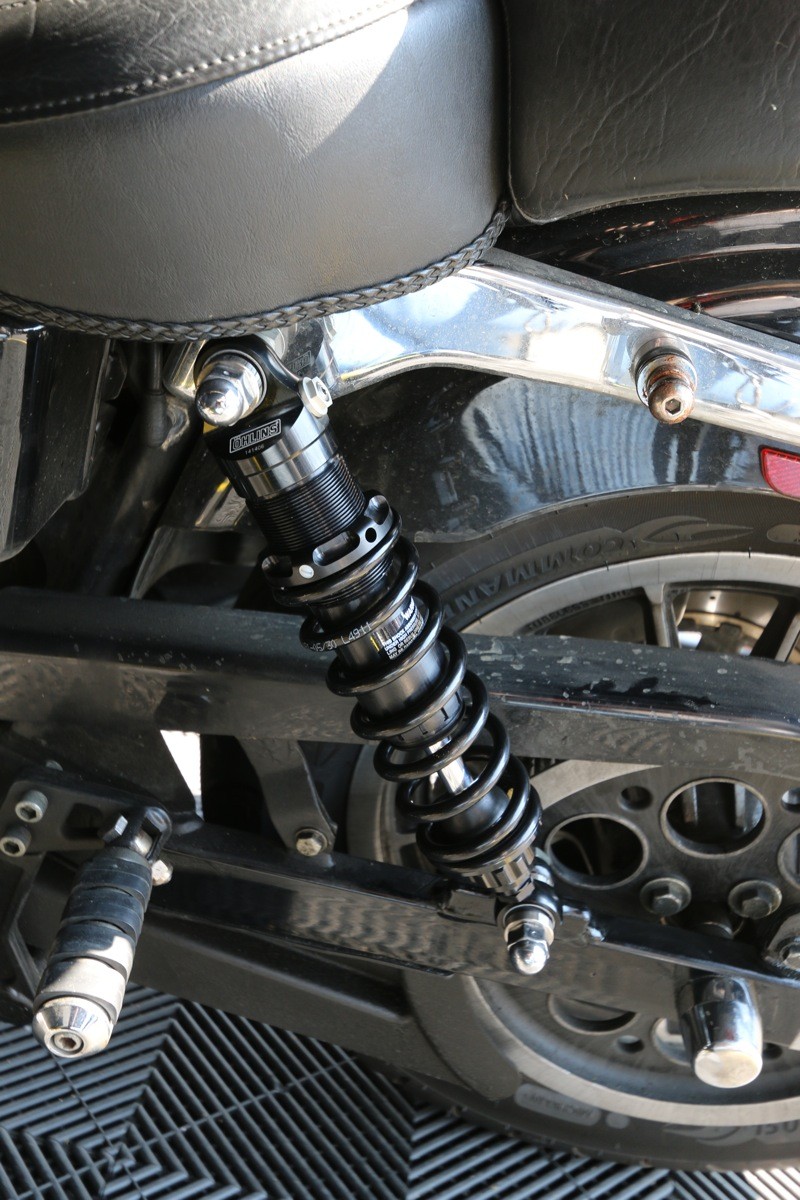Until recently, I was pretty happy with the set of aftermarket shocks that had been installed when my 2000 FXD was nearly new. However, when the shocks started to leak (my fault—I never had them serviced), it was an opportunity to try something new—the Öhlins STX36D Shock Absorbers. Öhlins is known as a top-of-the-line company founded in 1976 that provides suspension components for two- and four-wheel vehicles, and offers both racing and street products. In fact, the advanced technology used for on-road motorcycles is derived from racing applications where reliability, consistency and serviceability are absolute requirements.
During the Sturgis Motorcycle Rally, Öhlins USA sets up a tent at Black Hills Harley-Davidson in Rapid City, so I made an appointment to have the new shocks installed. The STX36 comes in either the dividing piston (STX36D) or piggyback (STX36P) version. Although both are gas pressurized, I selected the STX36D mostly because the STX36P has an external canister that wouldn’t have fit well behind the FXD’s aftermarket saddlebags.
The Blackline model’s cosmetics were specially designed for bikes that have exposed shocks, such as the Dyna and Sportster. The fully blacked-out shock is complemented by a chrome shaft, and really adds some visual pizzazz to my ride when the saddlebags are off. More important, though, is the design. Öhlins shocks allow owners to fine-tune the steering, feeling and impact of their bikes, and the internals of the shocks support that. The Blackline uses a proprietary hydraulic fluid and nitrogen gas at the top, with a piston separating the two. According to Öhlins, the shock does a much better job of dissipating energy and maintains its ride quality for long-distance riders. It doesn’t fade or “fatigue” as easily as a non-separated piston design.
Precision in manufacturing tolerances is another hallmark of Öhlins suspension. Each model of shock absorber (for my 2000 FXD, that part number is HD 762) is built specifically for the swingarm of each bike model, where the shocks mount and at what angle they “lay down.” So when a rebound change is made, it’s a precise and consistent change for every single click on the rebound damping adjuster.
When an order for shocks is placed with the company, the rider is asked to provide Öhlins, or an Öhlins-authorized dealer, with information so that the shocks can be customized for that rider. True to form, I was asked how much I weigh, if I regularly use saddlebags or hard cases, if I have a tour pack and if so, does it come on and off the bike, how much weight I generally carry in my luggage, and if I ride with a passenger, and if so, how often. The purpose of these questions is to set the spring rate for load changes so the geometry stays correct, meaning that it will steers well and provide stability without any wobbling, especially while taking corners and twisty roads. In addition, the install tech took measurements of the newly-installed shocks with me sitting on the bike as well as with the shocks extended to find out where I’m sitting in the shock “stroke” so the preload adjustment could be set more precisely.
The stock shocks on the 2000 FXD measure 12 5/8”, and the aftermarket shocks that were installed were very close, at 12 ½”. I had requested that the Blackline shocks be slightly lower, so the 12” shocks were selected. Öhlins doesn’t recommend lower-than-stock shocks because when the rear is lowered, the trail in front increases, which can introduce some low-speed instability and cause the bike’s steering to be a little heavier. Since the old shocks were so worn out, they sagged considerably when I sat on the bike, so the height difference between the old and new shocks was virtually nonexistent.
Packaged with the shocks is a pin tool (I keep mine in my saddlebag) that’s used to adjust the pre-load for weight changes. There’s also a dial at the bottom of the coil that adjusts the external rebound. And should I decide that I want the bike to sit slightly higher, the Blackline shocks are ride-height adjustable. Right below the external rebound dial is a jam nut that can be adjusted with open-end wrenches to extend the shock by nearly a half inch. It is recommended that the shock be removed before adjusting the length. Also included with the shocks are mounting instructions and an owner’s manual that provides detailed instructions for all adjustments.
When I first got on the bike after the installation, I immediately noticed a vast improvement in comfort and handling. My 1,800-mile ride back from Sturgis further confirmed the enhancements, as did a challenging ride through the Pennsylvania mountains the next weekend.
Öhlins shocks carry a five-year warranty against material defect or workmanship. What I need to keep in mind, though, is that I need to keep up with maintenance. The company recommends that the Blackline shocks be service every three years or 30,000 miles. I was advised not to wait until I experience degradation of the suspension because it happens so gradually I might never notice it. When it comes time, I can either bring the shocks to a dealer authorized to service the product, or send them to the Öhlins U.S-based service facility in Hendersonville, North Carolina.
Servicing the shock involves taking the gas pressure off, disassembling the shock, dumping out the oil and inspecting all wear items. Some of the parts will be replaced if needed, the oil put back in, the shock recharged with nitrogen gas to put pressure on the oil, and then the shock will be sent back. Servicing the shocks costs only a small part of what a new set would cost, and assures the shocks will always perform at their best.

















